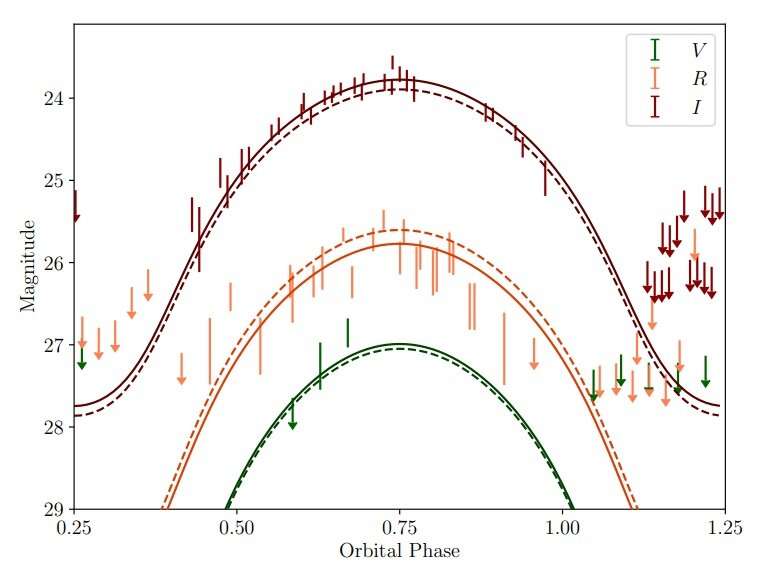March 21, 2022 report
Study investigates behavior of the 'black widow' millisecond pulsar PSR J0610‚àí2100

Tomasz Nowakowski
astronomy writer

Astronomers have performed a comprehensive study of a peculiar "black widow" millisecond pulsar known as PSR J0610‚àí2100. Results of this research, published March 11 on the arXiv pre-print repository, deliver essential information regarding the behavior and properties of this source.
The most rapidly rotating pulsars, those with rotation periods below 30 milliseconds, are known as millisecond pulsars (MSPs). Researchers assume that they are formed in binary systems when the initially more massive component turns into a neutron star that is then spun up due to accretion of matter from the secondary star.
A class of extreme binary pulsars with semi-degenerate companion stars is dubbed spider pulsars. These objects are further categorized as black widows if the companion has extremely low mass (less than 0.1 solar masses), while they are called redbacks if the secondary star is heavier.
Discovered in 2003, PSR J0610‚àí2100 is a black widow MSP with a spin period of about 3.86 milliseconds. The companion object has a mass of some 0.02 solar masses and orbits the neutron star every 6.86 hours. Previous observations of this system have detected that it shows optical variations, but found no evidence of orbital variations or radio eclipses.
A team of astronomers led by Emma van der Wateren of the ASTRON Netherlands Institute for Radio Astronomy in Dwingeloo, the Netherlands, decided to conduct radio observations of PSR J0610‚àí2100 with several radio telescopes and optical observations of the companion using the European Southern Observatory (ESO), hoping to get more insights into the nature of this source.
"We report on radio timing observations of the black widow binary pulsar J0610‚àí2100 and optical observations of its binary companion," the researchers wrote in the paper.
The radio timing measurements of PSR J0610‚àí2100 found no evidence of radio eclipses down to low frequencies or significant orbital period variations over the period of 16 years. The astronomers noted that the absence of radio eclipses in PSR J0610‚àí2100 is not unique as it was also reported in several other black widow systems. They explain that the absence of eclipses can be caused by either the absence of ionized material, or by the material missing the line of sight.
Furthermore, modeling of the optical light curve of the low-mass companion confirms the irradiation of this object by the pulsar. The researchers added that the companion is likely not filling its Roche lobe (a region around a star in a binary system within which orbiting material is gravitationally bound to that star), while having a relatively high inclination and that the irradiated hemisphere of this object has a surprisingly low temperature (about 2,820 K).
The authors of the paper speculate that the low temperature of the companion's irradiated side, together with a relatively low spin-down rate of PSR J0610‚àí2100, causes less mass lost in the evaporative wind. This, according to the scientists, may explain the absence of radio eclipses in this system.
Written for you by our author —this article is the result of careful human work. We rely on readers like you to keep independent science journalism alive. If this reporting matters to you, please consider a (especially monthly). You'll get an ad-free account as a thank-you.
More information: E. van der Wateren et al, Irradiated but not eclipsed, the case of PSR J0610‚àí2100. arXiv:2203.05872v2 [astro-ph.HE],
© 2022 Science X Network




















